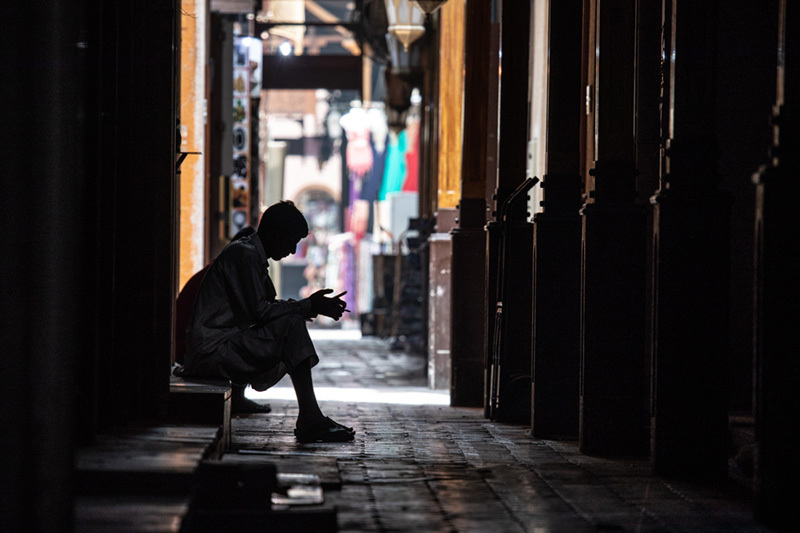
"Creating a Social Media Platform Where People Gather in an Empty Bazaar" photo by Masaki Nakamura
Globally, the push toward sustainability and the circular economy is accelerating. Achieving this requires more than just corporate "procurement, development, production, and distribution"; it hinges on how we engage people's actions—their "purchasing, use, and disposal (recovery)." This series explores what should be common globally and what should be localized within this trend.
This installment features Rie Tanaka, Dentsu Inc. SDGs Consultant, and Sayuri Nakagawa, Producer at DENTSU SOKEN INC., examining methods to encourage public participation in social good based on results from the " Social Good Awareness Survey " (*) jointly conducted by Dentsu Inc. and DENTSU SOKEN INC. in December 2020.
*Social Good Awareness Survey: Conducted among social media users in five countries: Japan, the UK, the US, China, and India. Social media usage includes SNS, video sharing sites/apps, and messenger apps.
<Table of Contents>
Why Do China and India Have Higher Social Good Awareness Than the West?
Here are the results of a survey on social good awareness in Japan, the UK, the US, China, and India. Several people who saw these results asked us, "The US and UK have long been active in social good activities, so why did China and India show higher percentages?" We believe the internet penetration rates in each country may have influenced the survey results.
【Internet Penetration Rate (2020)】
United Kingdom: 95%
Japan: 94%
United States: 90%
China: 59%
India 41%
Source: https://www.internetworldstats.com/stats.htm
Looking at the above, it appears there are countries where the internet is widely adopted and others where usage is likely concentrated in urban areas or among economically affluent segments. Regarding China and India, it is likely that the respondents to the internet survey included a high proportion of early adopters (those sensitive to trends, actively seeking information, and making their own judgments). Furthermore, while this survey uniformly targeted "social media users" (see the news release for detailed definitions), the proportion of people actively posting on social media accounts for about 80% of respondents in India and China.
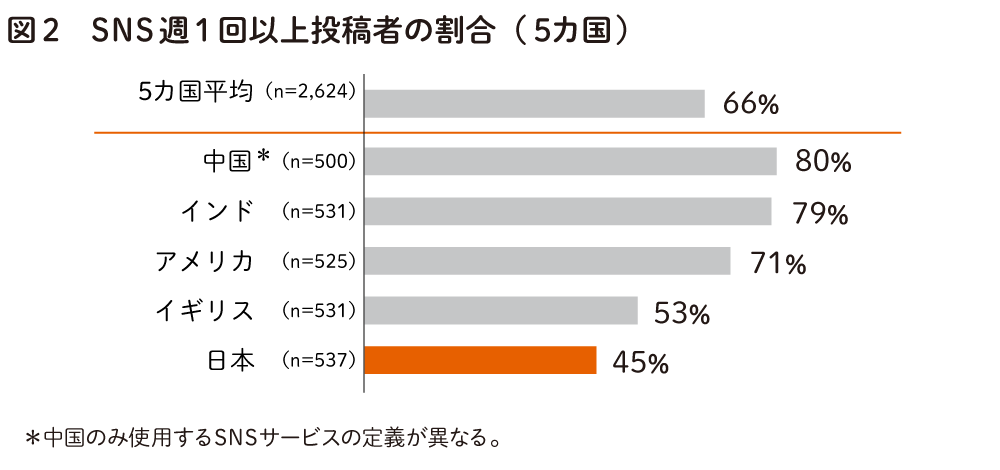
Japan and the UK have internet penetration rates exceeding 90%, with the vast majority also using social media. Japan's SNS usage rate is 69% ( according to the Ministry of Internal Affairs and Communications Information and Communications White Paper, 2020 edition). In this survey, "active SNS posters and primarily passive users are roughly equal." Compared to China and India, where SNS use centers around people with a certain standard of living or higher, Japan and the UK operate under the assumption that people from diverse backgrounds will see the content. This might make it harder for values to align in one direction.
During the 2020 stay-at-home period, positive solidarity on social media drew global attention. Examples include China's "加油 (Jia you - Hang in there)" posts gathering supportive comments and India's spread of the TikTok handwashing challenge "#LifebuoyKarona." These phenomena suggest that in India and China, the demographic driving social good constitutes the majority of social media users, creating fertile ground for sparking movements within these platforms.
SNS Posters as Social Good Mediators
Some may feel that "Japanese people are reserved, and refraining from speaking out is a virtue," and movements within SNS aren't always positive. However, thinking "Japan is different from other countries" too much can lead to missing opportunities to learn from others. Therefore, we will extract points we can learn from here.
The survey results in Figure 3 suggest that in Japan, "people who post on SNS at least once a week" tend to have a higher awareness of social good. If posting on SNS at least once a week influences consumption behavior, then engaging those for whom SNS posting is habitual becomes crucial in Japan as well, as they hold the key to the circular economy.
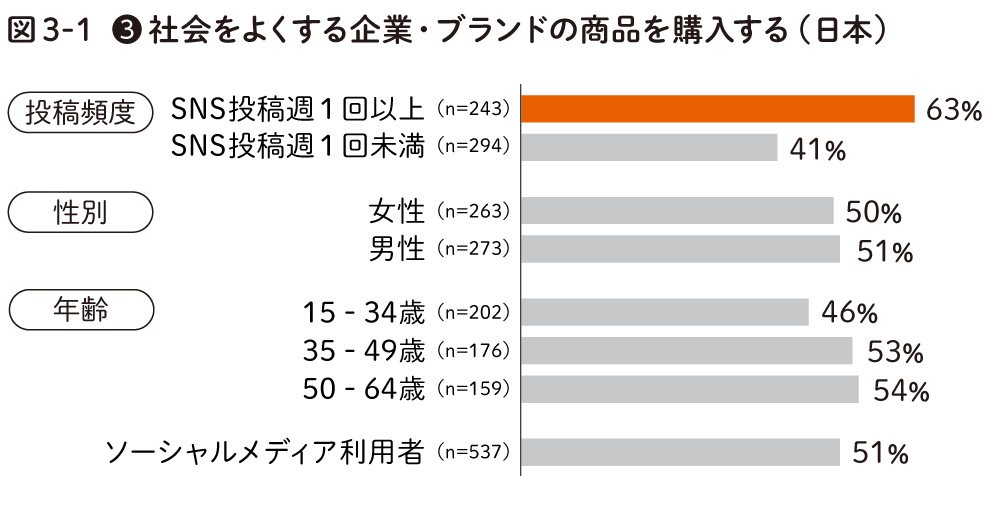
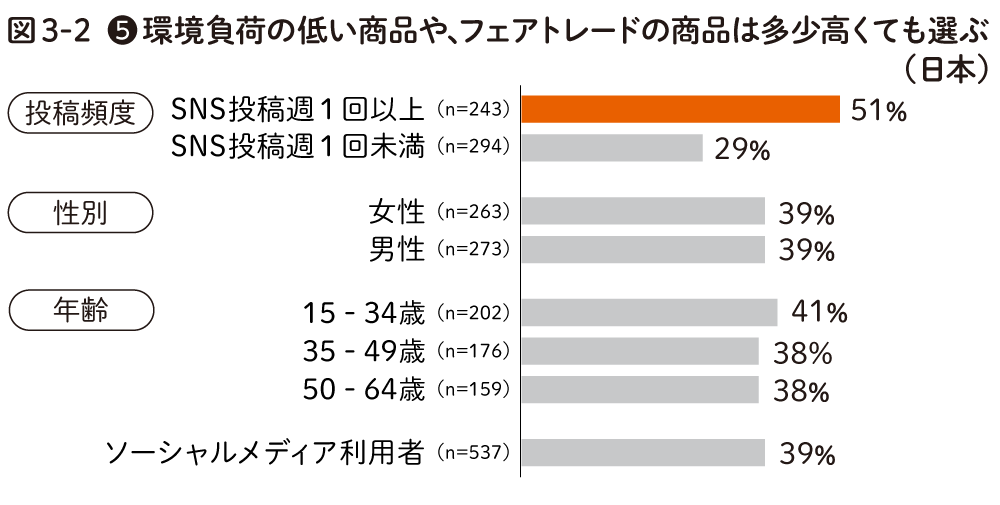
To avoid misunderstanding, it's important to note that social good awareness was not higher among heavy social media users—those who "use multiple SNS platforms" or "post multiple times daily" (the frequency of posting itself showed no correlation with social good awareness).
However, when looking at the loosely defined group of "those who habitually post on social media at least once a week," a higher level of social good awareness was confirmed across all countries. In other words, once a certain threshold is crossed, whether they post more or not doesn't matter. But when distinguishing between those who rarely post and only read versus those who habitually post, a difference in awareness was observed regardless of country.
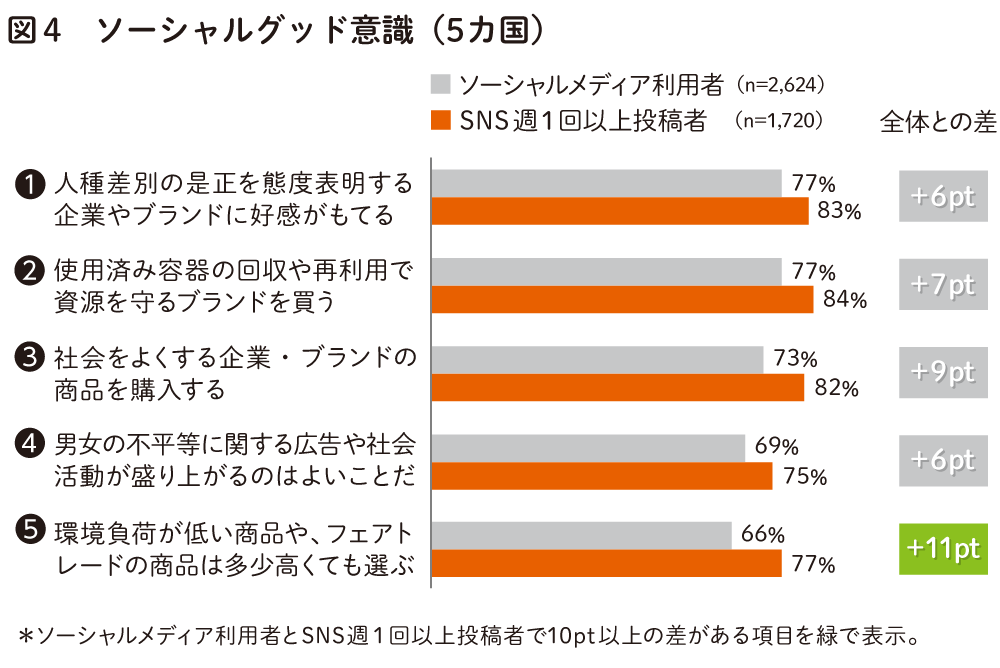
While SNS post content varies, consider "people who often act as intermediaries, sharing information with those around them." Even if people intellectually understand the importance of social good, if the world feels distant, they won't know how to act. However, if there are intermediaries, more people will feel the world is closer, making it easier for those who felt distant to participate. Even if their own posts are always about private moments, people with a posting habit are likely to "like" or "share" others' posts and news articles more frequently.
When more people connect the previously unseen world with their immediate surroundings through social media posters, social good activities become more likely to emerge. As Derek Sivers stated in his 2010 TED Talk, "How to Start a Social Movement" ( ), while the innovator who starts dancing first is important, it's the enthusiastic followers and endorsers who see this and join in dancing together that truly create a social movement.
Tips for Successfully Leading Corporate Social Good Initiatives
Finally, here are two key points for guiding corporate social good initiatives to success. The first is for the company to lead by "communicating a fact-based vision consistently and continuously from top management to all stakeholders over the long term."
This vision permeates only when it's not just a speech with keywords that change every year, but when the company's unique vision is communicated with consistency and continuity. It must be repeated at every opportunity, not just through words, but by demonstrating tangible actions that drive the business as an example. To use an analogy, if you don't recite prayers or family creeds regularly, you can't suddenly start reciting them in a crisis. What matters is embedding what to believe and how to act into everyday practice. While the vision may sometimes return to the founding principles or code of conduct, adding an SDGs vision can also be effective in driving future transformation.
When focusing on the circular economy, stakeholders extend beyond shareholders, employees, and customers; the vision must reach everyone involved in the value chain. Furthermore, by earning the trust of non-directly involved parties—such as local communities, NPOs/NGOs, and researchers—that the company is deeply committed to implementation, not just posturing, opportunities for collaboration open up.
Therefore, the importance of "communicating the vision long-term and continuously" to society at large, beyond just business-focused media targeting IR, is increasingly vital. This requires building relationships not only with IR-focused business media but also with media and organizations highly interested in sustainability.
Conversely, companies that take action but fail to communicate it risk being perceived as lacking transparency and social contribution. Regarding social good specifically, setting aside the virtue of modesty and actively communicating widely is itself one form of social contribution companies should undertake.
The second point, as demonstrated by this survey, is engaging social media influencers in social good activities. What motivates influencers to share isn't corporate activities themselves, but rather experiences they can mediate and convey—intelligent, interesting, shareable experiences that seem useful to others.
Therefore, companies must move beyond textbook "correct" messaging that risks making recipients passive (ME: "What's in it for me?") toward creating a sense of WE ("This sparks us to take initiative alongside the company"). Now more than ever, there's a need for a live, shared sense of urgency – a feeling that this is something we all must do together.
The key to success lies in weaving together the long-term, consistent PR from top management and the live, engaging feel that makes social media users want to participate – not treating them as separate efforts, but as part of a cohesive story. However, this cannot be achieved by a single specialized department within a company alone. It requires collaboration with stakeholders and various organizations to build a narrative that the whole society wants to contribute to. Crucially, each person must fully believe in their role and engage not as a side task, but as part of their core responsibilities.
Japan ranks 17th in the SDGs rankings, and its corporate, governmental, and educational initiatives are globally active. While people seem to have ample exposure, the survey still showed lower social good awareness compared to other countries. This might stem from a lack of communities where people can act as a "WE" to translate acquired knowledge into action. The " Gender Awareness Survey " released by DENTSU SOKEN INC. also indicates that perceptions of gender equality are low in areas outside of "school."
As Japan moves toward 2030, we will likely see increased activity from communities promoting social good, along with more social media posts sharing these activities. Companies actively engaging with these communities, creating shared vision experiences, and sometimes becoming members themselves to build connections—this could be the key to mobilizing WE.
[Survey Overview]
Title: "Social Good Awareness Survey (Japan, UK, US, China, India Edition)"
Survey Method: Web-based questionnaire survey
Conducted by: Dentsu Inc., DENTSU SOKEN INC.
Survey Period: December 13-21, 2020
Respondents: Social media users aged 15–64 in each country
Valid Sample Size: 2,624 respondents
(Japan: 537 respondents / UK: 531 respondents / USA: 525 respondents / China: 500 respondents / India: 531 respondents)











